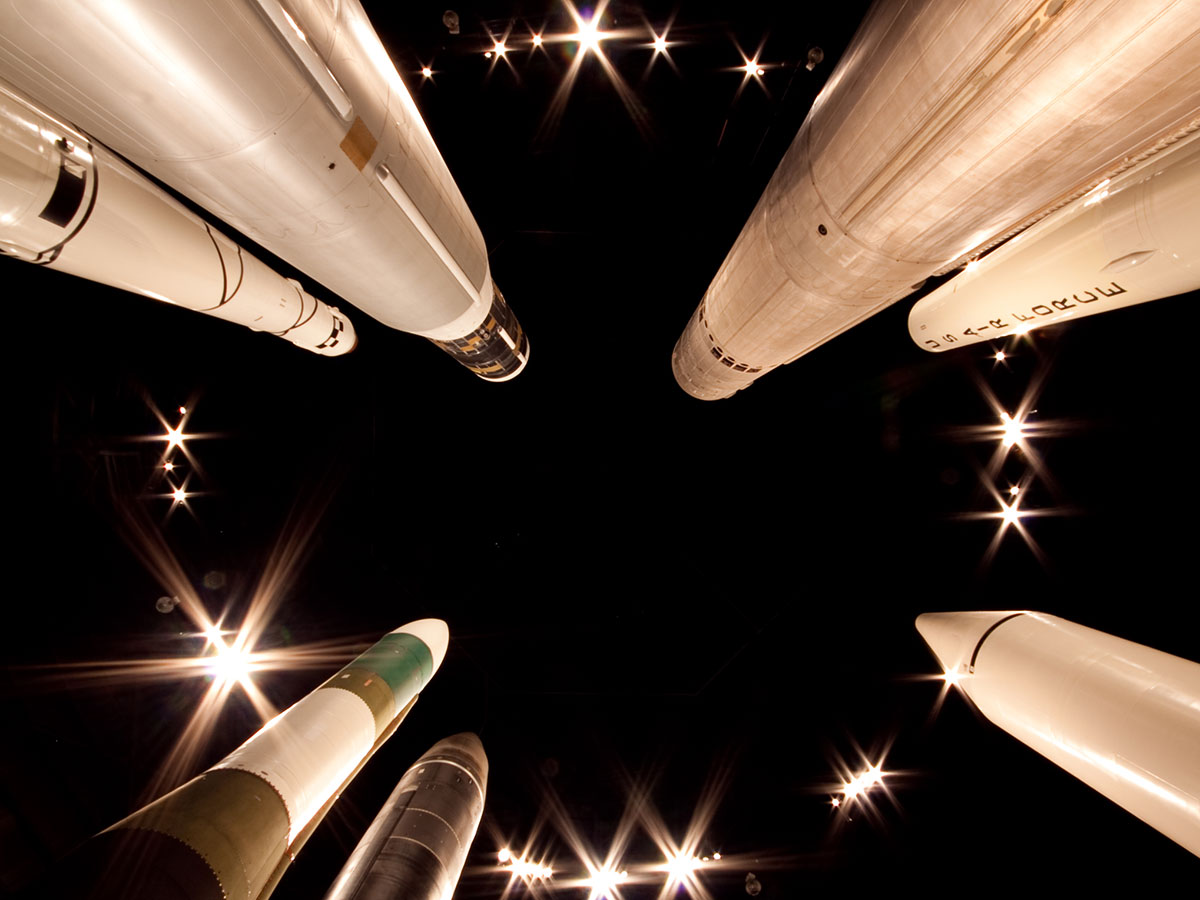Nuclear Arms Control: A Nuclear Posture Review Opportunity
6 Sep 2017
By Stephen J Cimbala for Air Force Research Institute (AFRI)
This article was external pageoriginally publishedcall_made by the external pageAir Universitycall_made in the Fall 2017 edition (Volume 11, Issue 3) of external pageStrategic Studies Quarterlycall_made.
Abstract
US nuclear posture includes national priorities for nuclear arms control. One important issue for the Trump administration is the possibility of extending or revising the New Strategic Arms Reduction Treaty (START) of 2010 that goes into effect in 2018 and expires in 2021. The analysis that follows compares outcomes from New START and lower numbers of deployed weapons for the United States and for Russia, in terms of their implications for deterrence and arms control stability. The significance of missile defenses in this context is also addressed, since Russia has defined US missile defenses as destabilizing with respect to nuclear arms control and potentially nullifying of Russia’s nuclear deterrent.
Vladimir Putin’s third term as Russian president conflicted with the goals of Barack Obama’s second term as US president. As a result, US-Russian political relations were mired in negativity, precluding the possibility of any follow-up agreement to the New START nuclear arms reduction treaty of 2010.1 If relations between the two countries eventually improve, should America and Russia extend New START or, with more ambition, seek post–New START reductions in their numbers of operationally deployed long-range nuclear weapons and launchers? This question must be considered part of the current US Nuclear Posture Review (NPR). The discussion that follows addresses this issue in four steps: (1) where things stand now, (2) options for strategic nuclear arms reductions, (3) the implications of missile defenses for nuclear strategic stability, and (4) conclusions and related discussion.
Nuclear Stasis
More than two and one-half decades after the end of the Cold War and the demise of the Soviet Union, post-Soviet Russia and the United States maintain numerous nuclear weapons deployed on intercontinental and transoceanic launchers, including land-based intercontinental ballistic missiles (ICBM), submarine-launched ballistic missiles (SLBM), and heavy bombers capable of carrying a variety of munitions, including gravity bombs, air-launched cruise missiles (ALCM), and advanced cruise missiles. Even after complying with the reductions called for in the New START agreement signed by presidents Obama and Medvedev in 2010, Russia and the United States will deploy a maximum number of 1,550 long-range or “strategic” nuclear weapons on a maximum of 700 deployed intercontinental launchers.2 In addition, a significant number of each state’s strategic nuclear weapons will require prompt launch for survivability, increasing the risk of nuclear instability in time of crisis.
It would be an understatement to say that the current nuclear relationship between the United States and the Russian Federation is an historical and strategic anomaly. Their nuclear arsenals remain sized in relation to each other and directly pointed at one another despite the fact that, were nuclear crisis management and deterrence to fail, no acceptable outcome to any nuclear war between the United States or NATO and Russia is foreseeable.3 To be sure, former President Obama’s national security strategy and nuclear policy documents indicated that, so long as nuclear weapons existed anywhere, the United States would maintain a nuclear force and supporting infrastructure second to none. And he was right: with nuclear weapons, bluffing is a dangerous game. States that want to play this game need to know, and their enemies must know, that their nuclear deterrent is safe, secure, reliable, and proof against either of two kinds of error. First, the US nuclear deterrent should be promptly responsive to duly authorized commands for nuclear retaliation after having been attacked—but the United States must not launch a nuclear retaliatory attack on a mistaken premise that an enemy has already launched a nuclear first strike. Second, US nuclear weapons also provide “extended deterrence” for American allies and, in so doing, support global nonproliferation by limiting those states’ vulnerability to nuclear coercion and/or attack, and thus reducing their incentives to become nuclear-weapons states.
How many weapons are needed to satisfy these criteria is an arguable question. Since the end of the Cold War, the United States and Russia have downsized their nuclear arsenals considerably. The New START limitations (1,550 deployed weapons on 700 deployed intercontinental launchers) for each state are a long way from the tens of thousands of deployed weapons that marked the height of the Cold War. Politically the United States and Russia have convergent and divergent interests. On the one hand, Russia’s annexation of Crimea in 2014 and continuing destabilization of eastern Ukraine have provoked NATO responses that include larger US and allied force deployments in Eastern Europe, including in states bordering Russia, as well as having boosted American and allied expenditures for conventional defense in Europe.4 On the other hand, Russia and the United States have at least partly overlapping and congruent interests in defeating terrorism, in a stable post-NATO Afghanistan, and in preventing the spread of nuclear weapons to rogue states or nonstate actors, including terrorists. In Europe, NATO seeks to maintain a spectrum of deterrent and defense capabilities to forestall aggression, to prevail in a conventional war if necessary, and to deter nuclear first use. NATO also faces the challenge of Russian hybrid warfare, including nonkinetic components such as cyberwar, active measures, disinformation, and varieties of influence operations. Although it is hoped that neither hybrid nor conventional warfare would escalate beyond the nuclear threshold, US strategic nuclear forces and other nuclear weapons deployed on the territories of NATO allies support NATO’s mission as being capable of deterring and resisting aggression at all levels. NATO requires this flexibility because, as military planners well know and history teaches, states often get the wars that they did not plan for or expect.
Granted, Russia maintains its strategic and shorter range nuclear forces for political and military reasons other than those having to do with its relations with the United States and NATO. Russia enjoys the cachet and spillover diplomatic suasion of being a nuclear superpower treated as an equal by the United States in nuclear arms control. Tables 1 and 2 summarize Russian and American strategic nuclear forces in 2016.
Table 1. Russia strategic nuclear forces, 2016
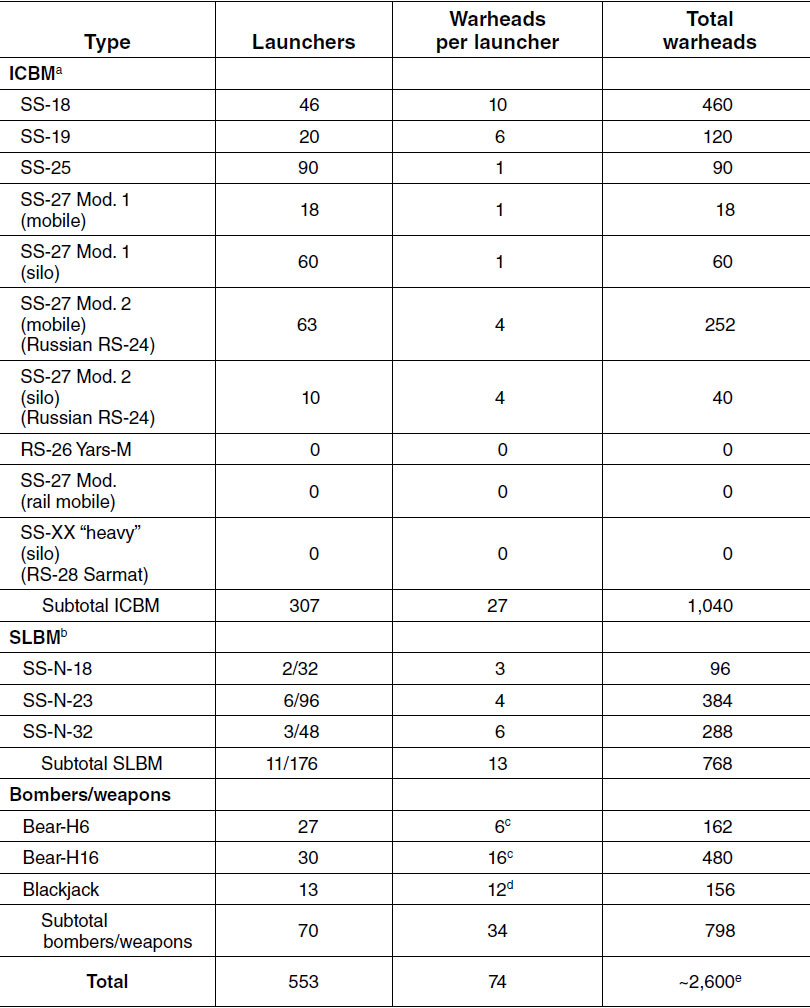
Table 2. US strategic nuclear forces, 2016
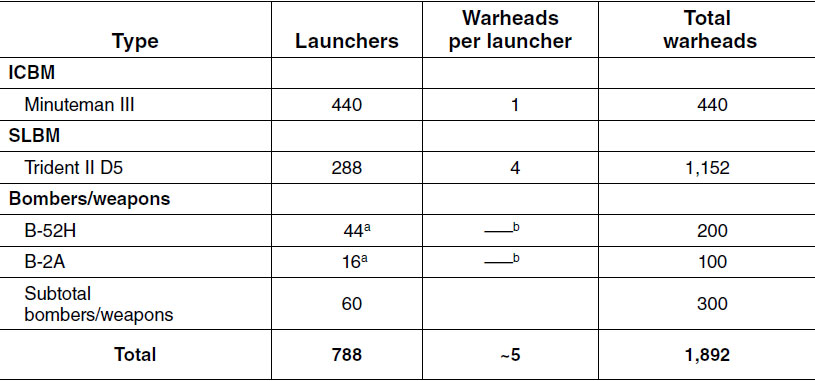
In military terms, Russia’s conventional (nonnuclear) forces are vastly inferior to those of the former Soviet Union and to those currently deployed by the United States and NATO. Although members of the alliance assume a NATO military attack on Russia is inconceivable, Russians fear that an imbalance in usable military power between NATO and Russia reduces Russia’s military shadow over contestable parts of the former Soviet space that Moscow regards as a zone of privileged interest.5 In addition, although Russian officials rarely speak of it in public, Russia cannot help but notice the increasingly competent and “wired” military of the People’s Republic of China and its higher profile in support of China’s expanded definition of its interests in Asia and elsewhere.6
But Russia would be mistaken to assume that nuclear weapons can, in the long run, compensate for deficiencies in its conventional armies, navies, and air arms of service. Leading Russian military thinkers have acknowledged the need for comprehensive military reform in everything from manpower policy to weapons modernization.7 Russia’s own documented interests in military cyberwar, together with its abysmal performance in the war against Georgia in 2008, are only two indicators of its recognition that nuclear weapons cannot resolve most of the outstanding security issues in Russia’s favor.8 Sooner or later, nuclear cover for conventional military weakness falls flat because nuclear weapons are uniquely blunt weapons of mass destruction, not weapons for prevailing in combat at an acceptable cost. Therefore, Russia’s putative case, that tactical nuclear weapons can be used for “de-escalation” of a conflict to Russia’s advantage that would otherwise pose an unacceptable loss of territory or sovereignty, is an example of military doublethink.9 This implies, or logically leads to, the following conclusion: Russian nuclear weapons, like those in America, will continue to be seen as a last-ditch option in peacetime and crisis by decision-makers with the practical effect that, unlike in the Cold War, their main utility is deterring each other rather than truly being tied tightly and seamlessly to a chain of promised escalation like that seen in US and Russian postures in the Cold War.
Options for Reductions
What do the preceding arguments suggest about the actual numbers of strategic nuclear weapons the United States and Russia might require for credible deterrence within the 2018–2021 time frame?10 Tables 3 through 7 illustrate some benchmarks by which one could measure the deterrence stability and military viability of US and Russian long-range nuclear forces. The tables summarize the outcomes of nuclear force exchanges for the United States and Russia under four assumptions about operational deployments.11 Tables 3 and 4 assume future Russian and American forces with maximum deployment limits as agreed under New START (1,550 weapons counted under New START rules). For comparison, tables 5 and 6 assume post–New START reductions to a lower maximum limit of 1,000 deployed weapons. In tables 7 and 8, each state is limited to a hypothetical force structure with a maximum limit of 500 operationally deployed weapons on transcontinental launchers.12
Table 3. US nuclear exchange outcomes (1,550 deployment limit)
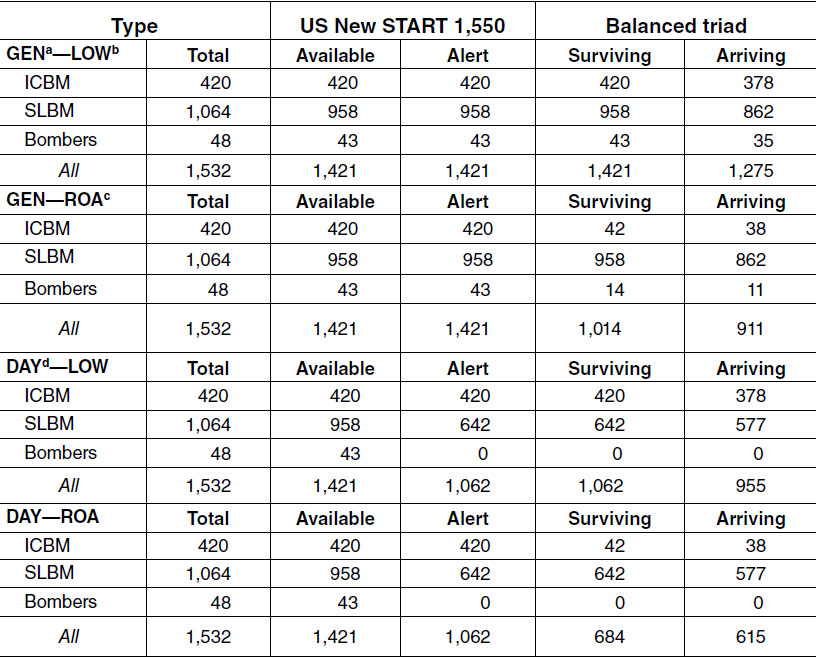
Table 4. Russia nuclear exchange outcomes (1,550 deployment limit)
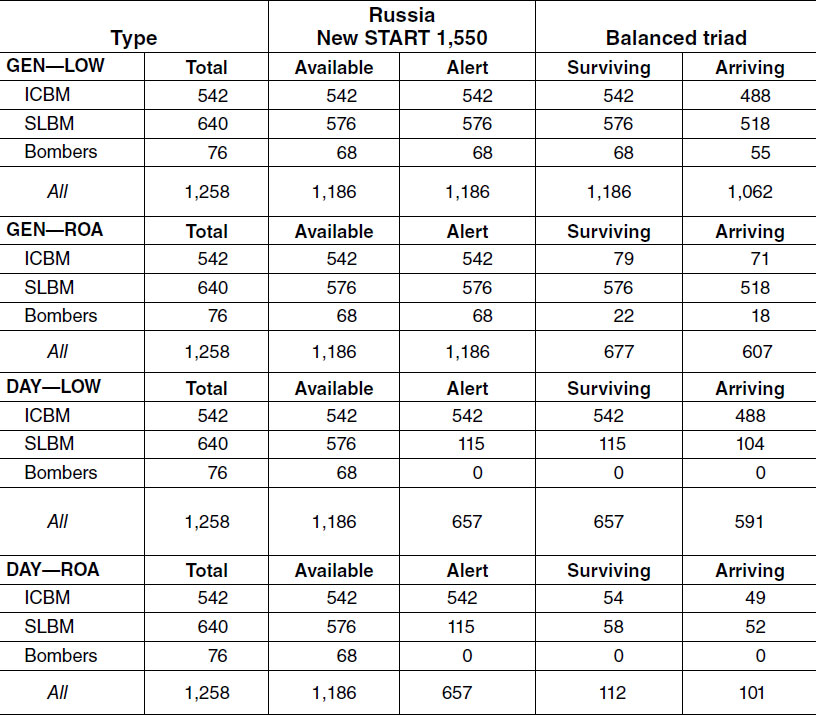
Table 5. US nuclear exchange outcomes (1,000 deployment limit)
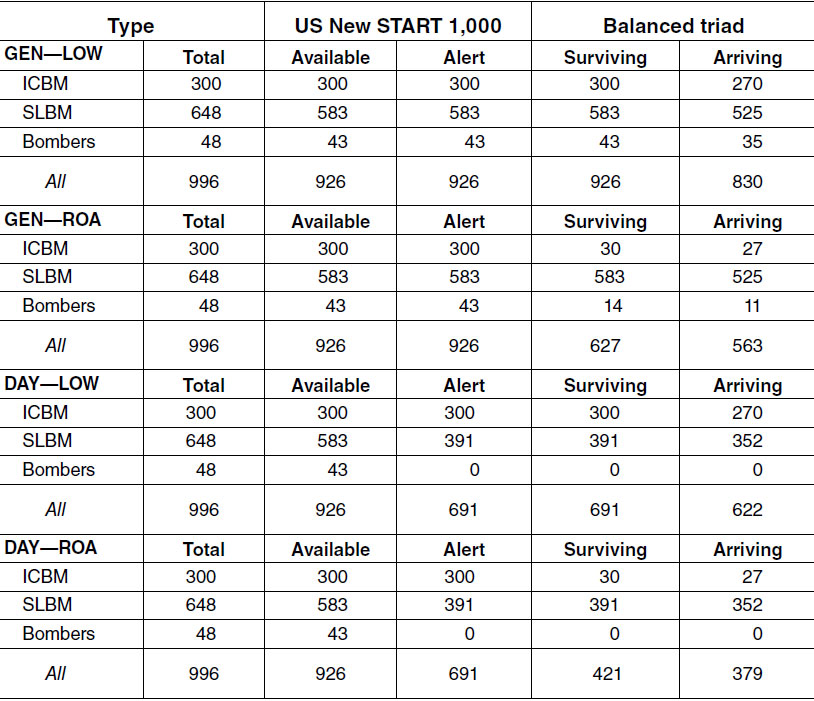
Table 6. Russia nuclear exchange outcomes (1,000 deployment limit)
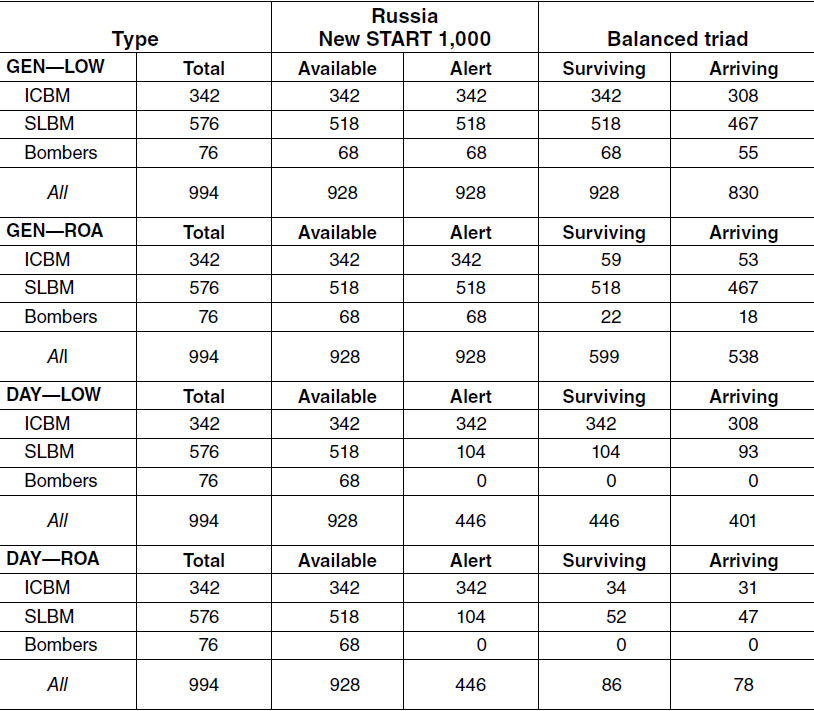
Table 7. US nuclear exchange outcomes (500 deployment limit)
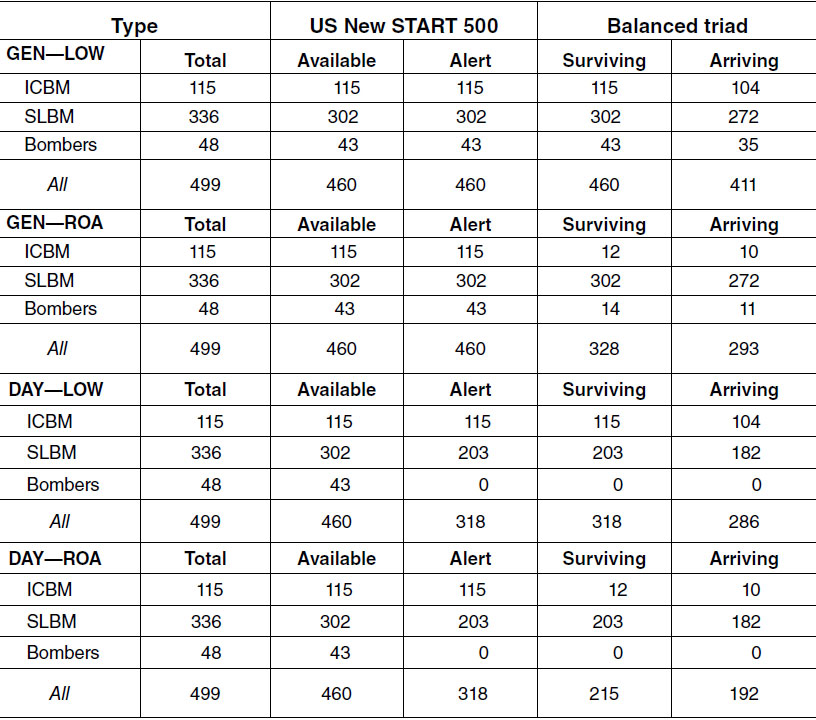
Table 8. Russia nuclear exchange outcomes (500 deployment limit)
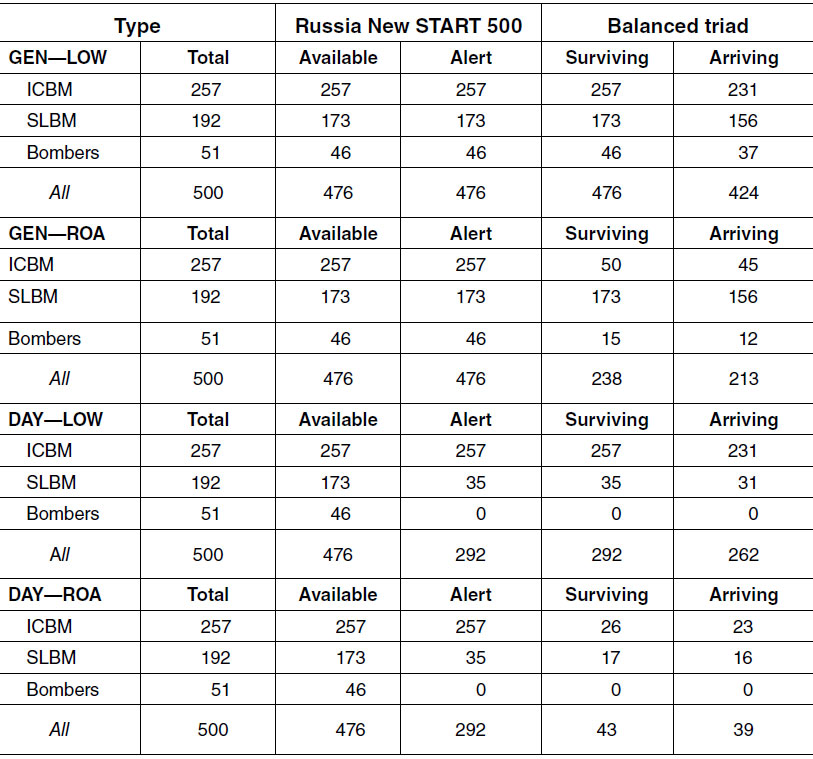
The preceding tables show that each state has numbers of surviving and retaliating weapons sufficient to satisfy the criterion of “unacceptable damage” in a second strike so long as unacceptable damage is defined by reference to the destruction of populations and societal values alone. If we use McGeorge Bundy’s formula of 10 weapons on 10 cities as a “disaster beyond history,” then even 500 deployed weapons provide several hundred retaliatory warheads for either side under plausible conditions of nuclear attack and response.13 However, this “city busting” criterion does not address the more nuanced requirements imposed on US (and doubtless Russian) military planners. Essentially, policy makers and planners have three paths or opportunities here: (1) drop the numbers of deployed weapons and launchers to a “minimum deterrent” standard, (2) agree to more limited nuclear reductions in a post–New START regime (New START light), and/or (3) “multilateralize” the arms-reduction talks to include China (essential if minimum deterrence is the goal but still useful if larger than minimum deterrent forces are being considered as the endgame).
What actually gets decided in Washington or in Moscow depends as much on politics as it does on strategy. On one hand, it will be difficult to sell domestic political forces in the United States (for example, Republican members of Congress) or in Russia (the Russian military-industrial complex) on post–New START reductions as drastic as a maximum deployment limit of 500 weapons. In addition, such a truly minimum deterrent option for the United States and Russia would require that the post–New START negotiations be expanded to include other nuclear weapons states. On the other hand, reductions to a maximum number of 1,000 operationally deployed weapons for each state should be politically feasible. Russia’s nuclear force modernization plans are ambitious but not necessarily affordable or otherwise feasible. The current status of Russia’s military-industrial complex is less than enviable. Russia’s nuclear warning and C3 system (command, control, and communications) system has serious deficiencies in satellite coverage and other weaknesses.14 It might turn out that Russia’s New START–compliant force will level off at some number below 1,550 deployed warheads and that Russia would be quite agreeable to the 1,000 benchmark for further reductions. At the same time, if a post–New START regime follows New START counting rules, each bomber would count as one weapon, and the actual number of weapons deployed by each state would exceed the notional deployment ceiling (1,000) by several hundred warheads. A US-Russian post–New START agreement for a maximum of 1,000 operationally deployed long-range weapons maintains their shared “nuclear superpower” status relative to other nuclear weapons states and should be considered one possibility for the nuclear posture review. This status, however, confers responsibilities on Moscow and Washington for taking the lead in reducing nuclear danger, including measures to prevent the further spread of nuclear weapons and to roll back existing cases of system-disturbing nuclear proliferation in states such as North Korea.
Missile Defenses: Prophecy or Problem?
Missile defenses, if successful, offer the possibility that deterrence by threat of unacceptable retaliation could be supported by deterrence based on denial of the attacker’s objectives.15 Today missile defenses remain technologically and politically contentious. Russian objections to the US- and NATO-proposed European Phased Adaptive Approach (EPAA) to missile defenses remained emphatic even as US Department of Defense studies cast doubt on the technical proficiency of the proposed components for the European BMD (ballistic missile defense) systems.16 A study by the National Academy of Sciences (NAS) on missile defense technologies called into question some of the thinking of the Obama administration and the Missile Defense Agency about the priority of certain missions and technologies for BMD.17 But other expert scientists criticized the NAS study as containing “numerous flawed assumptions, analytical oversights, and internal inconsistencies” leading to “fundamental errors in many of the report’s most important findings and recommendations” and as undermining its scientific credibility.18
Future technology challenges to the development and deployment of missile defenses will have more to do with the complexity of software engineering for multiple contingencies and players, compared to the bipolar and physics-centric context of the Cold War.19 Suffice it to say that the academic and policy arguments continue as to the feasibility and desirability of building missile defenses, alongside the inertial pull of research and development funding in this direction since the Reagan administration’s Strategic Defense Initiative.20 But this issue remains important to the nuclear posture review.
If the linkage between US and NATO plans for European missile defenses and further progress in US-Russian strategic nuclear arms reductions was not yet a hostage relationship, it was clearly a problematical connection.21 The New START agreement does not preclude the United States from deploying future missile defenses, despite Russian efforts during the negotiating process to restrict American degrees of freedom in this regard.22 Former Russian president Dmitri Medvedev and his predecessor-successor Vladimir Putin made it clear that Russia’s geostrategic perspective links US and NATO missile defenses to cooperation on other arms control issues. Meanwhile, in 2011 the United States and NATO moved forward with the first phase of a four-phase deployment of the EPAA for missile defenses.23 In March 2013, secretary of defense Chuck Hagel announced plans to modify the original plan for EPAA by abandoning the originally planned deployments of SM-3 IIB interceptor missiles in Poland by 2022. But this step failed to reassure Russian skeptics about the claims that US and NATO regional and global missile defenses were not oriented against Russia. Russian officials frequently reiterate demands for a legally binding guarantee from the United States and NATO that Russian strategic nuclear forces would not be targeted or affected by the system.24 Table 9 summarizes the status of the EPAA BMD as of autumn 2013.
Although the prospects for US-Russian or NATO-Russian agreement on European missile defenses might seem challenging at this writing, the prospects for American cooperation with allies and partners outside of Europe on regional missile defenses are more favorable. The potential bull market for missile defenses lies in Asia, including prompts from Sino-Japanese rivalry, North Korean threats and missile tests, and deterrence challenges between India and Pakistan. Missile defenses might appeal to states in Asia as support for deterrence by denial of enemy attack and as a means of damage limitation, should deterrence fail. Missile defenses for some US allies and partners might also reinforce security guarantees based on the American nuclear umbrella and consequently reduce the incentives for those states to develop their own nuclear arsenals.25 Each of these BMD aspects have direct bearing on and relevance to the US nuclear posture review.
Table 9. European phased adaptive approach to missile defense
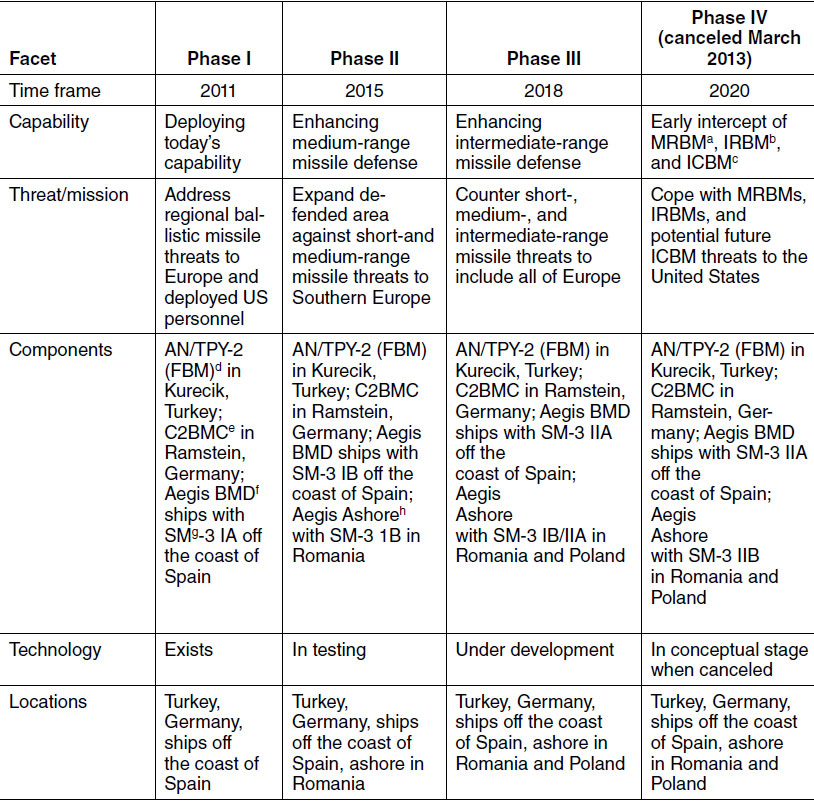
Beyond the Nuclear Posture Review per se, the question of missile defenses raises important issues having to do with the relationship between the politics and the technology of deterrence. Missile defenses that are “too good” potentially undermine stable deterrence based on assured retaliation that inflicts unacceptable damage. But a mixture of defenses of uncertain performance with offenses threatens to create an open-ended arms race and additional uncertainties that, during a crisis, might contribute to first-strike fears. Added to this, new technologies for improved accuracy in long-range strike weapons and better remote sensing could pose greater threats to platform survivability based on hardening or concealment. And, once having been deployed, defenses would themselves become attractive targets for defense-suppression attacks, creating incentives for pre-preemptive strikes against defenses while preemption against enemy offensive forces remained on the table. To be clear, the next NPR will have to address how offenses and defenses work together to (1) support deterrence and defense policy objectives and (2) remember the lessons learned from years of Cold War and later experience about the unique character of nuclear weapons and nuclear danger, albeit in a changing world.
Conclusions and Recommendations
The United States and Russia have opportunities for nuclear arms reductions if other issues of military-strategic disagreement, including Russia’s possible violation of the INF Treaty, can be managed successfully. However, arms control is primarily a political process, not a technical one. The two states must agree that their leadership on global nonproliferation and nuclear risk reduction is a matter of priority on account of their large arsenals, their high visibility in nuclear world politics, and their experience in nuclear consultation and negotiation. Analysis shows that US-Russian strategic nuclear stability is possible at various levels of deployed warheads and launchers. The Trump administration’s nuclear posture review might be just the occasion for new ideas, including new departures in nuclear arms control. Several possibilities and recommendations emerge.
1. The United States and Russia should agree now to extend the duration of the New START treaty and, in addition, enter into discussions about post–New START reductions consistent with strategic stability.
2. Military-to-military exchanges between US and Russian specialists, suspended during the Obama administration, should be resumed in the interest of transparency and security.
3. US-Russian arms-reduction talks should deal not only with simple counts and verification but also with the larger contexts of strategy and security as perceived by both states; for example, what are the consequences of possible improvements in missile defenses and in conventional long-range precision strike weapons, for nuclear deterrence based on assured retaliation?
4. Since the likelihood of a tactical nuclear first use is higher than the probability of a separate decision for a strategic nuclear first strike, more transparency about NATO and Russian tactical nuclear weapons deployed in Europe and in Asia is essential. An outbreak of accidental or inadvertent nuclear war growing of out of an escalation from conventional war is as likely, or more likely, than a mistaken strategic nuclear response per se. At the same time, smaller weapons are, for deterrence purposes, ambiguously connected to the possible employment of larger and more destructive forces. Tactical nuclear weapons are linked to strategic weapons because of the complex dual nature of the former: they are possible firebreaks between lesser and greater degrees of war. The process of negotiating increased transparency with respect to the numbers, locations, and capabilities of tactical nukes should begin now.26 But the road to tactical nuclear arms reductions as between NATO and Russia is a much more difficult problem than further reductions in US and Russian strategic nuclear weapons, and for that reason it requires a separate study in its own right.
5. US-Russian cooperation on theater missile defenses in Europe should be encouraged, including the development of joint centers of observation and monitoring against threats from the Middle East or other outside-of-Europe locations. Current generations of strategic antimissile defenses are promissory notes, not proven technologies under conditions of wartime stress.27 Russian officials continue to assert nevertheless that current and prospective US missile defense plans threaten the viability of Russia’s nuclear deterrent and, therefore, international stability.28 Doubtless future antimissile technologies will improve relative to ballistic offensive weapons, given the ages of the latter.29 However, the ultimate outcome of competition between defensive antimissiles and offensive countermeasures remains at the mercy of creative science and engineering as well as politics and state priorities.30 US- and NATO-proposed missile defenses for Europe are admittedly a matter of contemporary controversy.31 But they should not be an excuse for Russia, the United States, or NATO to defer progress on strategic and nonstrategic nuclear reductions in offensive weapons.
Many of these recommendations might be grouped under the heading of creating new, or revived, knowledge communities among armscontrol specialists and others in the national security and military studies worlds. These communities would cut across professional and national boundaries to bring together interested specialists and policy makers for discussions about their perspectives on nuclear deterrence, crisis management, nonproliferation, nuclear security, and other issues. Something like this occurred between the United States and the Soviet Union during the Cold War. Over time, shared expectations and understandings about the bases of nuclear deterrence, the “deliverables” possible in arms control, and the challenges of nuclear crisis management helped to control the arms race and bring a peaceful end to the Cold War. In the twenty-first century, academics and practitioners will have to shepherd understandings about the relationship between offenses and defenses, the implications of cyberwar for nuclear deterrence, and the impact of third offset technologies (artificial intelligence, nanotechnology, and 3-D manufacturing, among others) on nuclear arms control and deterrence strategy. In addition, the conversation on strategic nuclear arms control must move from a two-sided American and Russian experience toward a tripartite nuclear summitry that includes China, despite individual, different policy objectives, experiences, and strategic perspectives with respect to nuclear weapons.
With regard to arms control more generally, Paul Bracken emphasizes that the challenges of the second nuclear age may be very different from the first: “Arms control is in desperate need of fresh ideas. It’s like Sanka, an old, tired brand that is still around but in need of a makeover. I want to put the challenge to arms control in just this way. Without new energy and a new edginess, arms control’s downward spiral into irrelevance will continue. Arms control is too important to allow this to happen.”32
The nuclear posture review presents an opportunity for fresh ideas and new energy to prevent the collapse and relevance of arms control. The Trump administration and the Department of Defense should seize this opportunity before it fades away.
Notes
1. For example, see Peter Baker, Neil MacFarquhar, and Michael R. Gordon, “Syria Strike Puts U.S. Relationship with Russia at Risk,” New York Times, 7 April 2017, https://www.nytimes.com/2017/04/07/world/middleeast/missile-strike-syria-russia.html.
2. Treaty between the United States of America and the Russian Federation on Measures for the Further Reduction and Limitation of Strategic Offensive Arms (Washington, DC: Department of State, 8 April 2010), http://www.state.gov/documents/organization/140035.pdf.
3. Aaron Mehta, “Former SecDef Perry: US on ‘Brink’ of New Nuclear Arms Race,” Defense News, 3 December 2015, http://www.defensenews.com/story/defense/policy-budget/2015/12/03/former-secdef-perry-us-brink-new-nuclear-arms-race/76721640/.
4. Philip M. Breedlove, “NATO’s Next Act: How to Handle Russia and Other Threats,” Foreign Affairs, July/August 2016, https://www.foreignaffairs.com/articles/europe/2016-06-13/natos-next-act. On current and prospective Russian strategic military thinking, see Stephen R. Covington, The Culture of Strategic Thought behind Russia’s Modern Approaches to Warfare (Cambridge, MA: Belfer Center, Harvard Kennedy School, October 2016).
5. BBC, “Russia Security Paper Designates NATO as Threat,” 31 December 2015, http://www.bbc.com/news/world-europe-35208636.
6. See, for example, Mark B. Schneider, Testimony before the U.S.-China Economic and Security Review Commission, Hearing on “Developments in China’s Cyber and Nuclear Capabilities,” 26 March 2012, http://www.uscc.gov/sites/default/files/3.26.12schneider.pdf; and Office of the Secretary of Defense, Annual Report to Congress, Military and Security Developments Involving the People’s Republic of China 2014 (Washington, DC: Office of the Secretary of Defense, 2014), https://www.defense.gov/Portals/1/Documents/pubs/2014_DoD_China_Report.pdf.
7. For example, see Ariel Cohen and Robert E. Hamilton, The Russian Military and the Georgian War: Lessons and Implications (Carlisle, PA: Strategic Studies Institute, US Army War College, June 2011); and Rod Thornton, Military Modernization and the Russian Ground Forces (Carlisle, PA: US Army War College, June 2011).
8. Timothy L. Thomas, Russia: Military Strategy: Impacting 21st Century Reform and Geopolitics (Fort Leavenworth, KS: Foreign Military Studies Office, 2015), 253–99. Thomas discusses Russian concepts of information warfare and related policy and planning decisions.
9. For an expert appraisal of Russian military thinking about tactical nuclear weapons, see Jacob W. Kipp, “Russian Doctrine on Tactical Nuclear Weapons: Contexts, Prisms, and Connections,” in Tactical Nuclear Weapons and NATO, ed. Tom Nichols, Douglas Stuart, and Jeffrey D. McCausland (Carlisle, PA: U.S. Army War College, April 2012), 116–54. See also Olga Oliker, “No, Russia Isn’t Trying to Make Nuclear War Easier,” National Interest,
23 May 2016, http://nationalinterest.org/feature/no-russia-isnt-trying-make-nuclear-war-easier-16310.
10. Regardless the outcome of the analysis, the exercise is necessary in order to impose analytical boundaries on the discussion. See Keith B. Payne, “Why US Nuclear Force Numbers Matter,” Strategic Studies Quarterly 10, no. 2 (Summer 2016): 14–24, http://www.au.af.mil/au/ssq/digital/pdf/Summer16/Payne.pdf.
11. Grateful acknowledgment is made to James Scouras for use of his Arriving Weapons Sensitivity Model in this study. Dr. Scouras is not responsible for its use here or for any arguments in this paper.
12. Force structures in the analysis are notional and not necessarily predictive of actual deployments. For expert appraisal, see, in addition to previous citations, Hans M. Kristensen, “Trimming Nuclear Excess: Options for Further Reductions of U.S. and Russian Nuclear Forces,” Special Report no. 5 (Washington, DC: Federation of American Scientists, December 2012), https://fas.org/pub-reports/trimming-nuclear-excess/; Gen James Cartwright, retired, chair, Global Zero Nuclear Policy Commission, Report: Modernizing U.S. Nuclear Strategy, Force Structure and Posture (Washington, DC: Global Zero, May 2012), https://www.globalzero.org/files/gz_us_nuclear_policy_commission_report.pdf; and Pavel Podvig, “New START Treaty in Numbers,” Russian Strategic Nuclear Forces (blog), 9 April 2010, http://russianforces.org/blog/2010/03/new_start_treaty_in_numbers.shtml. See also Joseph Cirincione, “Strategic Turn: New U.S. and Russian Views on Nuclear Weapons,” New America Foundation, 29 June 2011, http://newamerica.net/publications/policy/strategic_turn; and Arms Control Association, “U.S. Strategic Nuclear Forces under New START,” external pagehttp://www.armscontrol.org/factsheets/USStratNukeForceNewSTARTcall_made.
13. McGeorge Bundy, “To Cap the Volcano,” Foreign Affairs 48, no. 1 (October 1969): 10, http://doi.org/d6mc7p.
14. Russia’s strategic nuclear forces and their progression may be followed on Pavel Podvig’s expert blog, Russian Strategic Nuclear Forces. See, for example, “New START Treaty in Numbers,” n. 12.
15. According to Adam B. Lowther, deterrence can be conceptualized as a continuous spectrum with three components: deterrence by dissuasion, deterrence by denial, and deterrence by threat. Moving across the spectrum from dissuasion through denial to threat increases the level of action by the state attempting to deter. See Lowther, “How Can the United States Deter Nonstate Actors?” in Deterrence: Rising Powers, Rogue Regimes, and Terrorism in the Twenty-first Century, ed. Adam Lowther (New York: Palgrave-Macmillan, 2012), 163–82, esp. 166–67.
16. Desmond Butler, Associated Press, “Flaws Found in U.S. Missile Shield for Europe,” Army Times, 9 February 2013, http://www.armytimes.com/mobile/news/2013/02/ap-flaws-missile-shield-020913. See also “U.S. Missile Defense Shield Flawed: Classified Studies,” Russia Today, 9 February 2013, https://www.rt.com/usa/us-missile-defense-flaws-811/.
17. Committee on an Assessment of Concepts and Systems for U.S. Boost-Phase Missile Defense in Comparison to Other Alternatives, Making Sense of Ballistic Missile Defense (Washington, DC: National Research Council, National Academy of Sciences, National Academies Press, 2012), https://www.nap.edu/read/13189/chapter/1.
18. George N. Lewis and Theodore A. Postol, “The Astonishing National Academy of Sciences Missile Defense Report,” Bulletin of the Atomic Scientists, 20 September 2012, http://thebulletin.org/astonishing-national-academy-sciences-missile-defense-report.
19. Rebecca Slayton, Arguments that Count: Physics, Computing, and Missile Defense, 1949–2012 (Cambridge, MA: MIT Press, 2013), 188–97.
20. Superior treatment of technical, political, and economic challenges to US and NATO plans for European missile defenses is provided in Steven J. Whitmore and John R. Deni, NATO Missile Defense and the European Phased Adaptive Approach: The Implications of Burden Sharing and the Underappreciated Role of the U.S. Army (Carlisle, PA: US Army War College, October 2013).
21. For US and NATO missile defense plans, see LTG Patrick J. O’Reilly, USA, director, Missile Defense Agency, “Ballistic Missile Defense Overview” (presentation, 10th Annual Missile Defense Conference, Washington, DC, 26 March 2012, https://mostlymissiledefense.files.wordpress.com/2013/06/bmd-update-oreilly-march-2012.pdf.
22. Treaty between the United States of America and the Russian Federation.
23. See Karen Kaya, “NATO Missile Defense and the View from the Front Line,” Joint Force Quarterly 71 (4th Quarter 2013): 84–89, http://ndupress.ndu.edu/JFQ/Joint-Force-Quarterly-71/; John F. Morton and George Galdorisi, “Any Sensor, Any Shooter: Toward an Aegis BMD Global Enterprise,” Joint Force Quarterly 67 (4th Quarter 2012): 85–90, http:// ndupress.ndu.edu/Portals/68/Documents/jfq/jfq-67/JFQ-67_85-90_Morton-Galdorisi.pdf; and Frank A. Rose, deputy assistant secretary, Bureau of Arms Control, Verification and Compliance, “Growing Global Cooperation on Ballistic Missile Defense, Remarks as Prepared, Berlin, Germany,” 10 September 2012, http://www.state.gov/t/avc/rls/197547.htm.
24. For example, see RIA Novosti, “Moscow Needs More ‘Predictability’ in NATO Missile Defense Plans,” Sputnik News, 23 October 2013, https://sptnkne.ws/eHdh.
25. See Kevin Ayers, “Expanding Zeus’s Shield: A New Approach for Theater Ballistic Missile Defense in the Asia-Pacific Region,” Joint Force Quarterly 84 (1st Quarter 2017): 24–31, http://ndupress.ndu.edu/Portals/68/Documents/jfq/jfq-84/jfq-84_24-31_Ayers.pdf, for a discussion of challenges and opportunities. See also essays in The Asia-Pacific Century: Challenges and Opportunities, ed. Adam Lowther (Maxwell Air Force Base, AL: Air University Press, April 2013).
26. Pavel Podvig, “What to Do about Tactical Nuclear Weapons,” Bulletin of the Atomic Scientists, 25 February 2010, https://web.archive.org/web/20100504022115/http://www.thebulletin.org:80/web-edition/columnists/pavel-podvig/what-to-do-about-tactical-nuclear-weapons.
27. Slayton, Arguments that Count, 199–226. Slayton offers pertinent historical perspective. See also Keir Giles with Andrew Monaghan, European Missile Defense and Russia (Carlisle, PA: Strategic Studies Institute, US Army War College Press, July 2014); and Andrew Futter, Ballistic Missile Defence and US National Security Policy: Normalization and Acceptance after the Cold War (New York: Routledge, 2013).
28. For example, at the Geneva disarmament conference in March 2017, Lieutenant General Viktor Poznikhir, deputy head of the Main Operations Department of the Russian General Staff, averred that deployment of US missile defenses “ruins the current system of international security” and that “the United States hopes to gain strategic advantage by downgrading the deterrence potentials of Russia and China. This may cause serious effects in the field of security.” Poznikhir, cited in “Military Expert Warns US ABMs Can Detect Any Missile Shield, Even Russian Ones,” TASS, 28 March 2017, http://tass.com/defense/937949.
29. For example, the possibility of “left-of-launch” techniques for interfering with enemy missile launches before missiles actually reach the launch pad or during the launch itself. See David E. Sanger and William J. Broad, “Trump Inherits a Secret Cyberwar against North Korean Missiles,” New York Times, 4 March 2017, https://www.nytimes.com/2017/03/04/.../north-korea-missile-program-sabotage.html.
30. Morton and Galdorisi, “Any Sensor, Any Shooter.”
31. For US and NATO missile defense plans under the European phased adaptive approach, see Kaya, “NATO Missile Defense,” and O’Reilly, “Ballistic Missile Defense Overview.”
32. Paul Bracken, The Second Nuclear Age: Strategy, Danger, and the New Power Politics (New York: Henry Holt–Times Books, 2012), 260–61. For an illustration of some new approaches, see the collaborative work between RAND and the Korea Institute for Defense Analyses in Paul K. Davis, Peter Wilson, Jeongeun Kim, and Junho Park, “Deterrence and Stability for the Korean Peninsula,” Korean Journal of Defense Analysis 23, no. 1 (Spring 2016): 1–23, http://www.kida.re.kr.
About the Author
Stephen J. Cimbala is a distinguished professor of political science at Penn State–Brandywine and author of numerous works on national security, nuclear arms control, deterrence, and missile defense. His most recent book is Nuclear Weapons in a Multipolar World (New York: Routledge, 2016).
The thumbnail external pageimagecall_made is courtesy of David Darroch/Flickr. (CC BY-NC-ND 2.0)
For more information on issues and events that shape our world, please visit the CSS Blog Network or browse our Digital Library.

